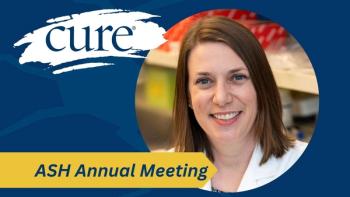
Role of Watchful Waiting in CLL
Transcript: Nicole Lamanna, M.D.: Initially, when patients are diagnosed with chronic lymphocytic leukemia [CLL], they’re often told that they don’t need any treatment and are monitored. This is a little unusual for patients, obviously, who get diagnosed and are told that they have a blood cancer or any cancer. They’re told, “We’re not treating you right now. We’re going to monitor you.” And that certainly can cause a little bit of concern, or obviously a little worry and anxiety. I think that’s completely normal, when somebody is first told that they have a new diagnosis of any cancer.
And this is atypical for cancers, in general, because if you’re diagnosed with breast cancer or lung cancer you’re going to go under treatment, whether that be surgery, or chemotherapy, or radiation, and you’re treated right away for that cancer. This is a little bit unique, and we’re going to talk about this: What they call watchful wait, or in some patients, watchful worry. They’re told that they’re going to be monitored for a period of time. Danise, is that exactly what you were told?
Danise Hoover: Yes, pretty much. But, you know, I found that to be kind of a good thing.
Nicole Lamanna, M.D.: I like that.
Danise Hoover: I’m happy to just let it be for a while. And this fit in exactly with what the internist who originally diagnosed me had told me. I also did some research on the disease, and that was the same thing that my research confirmed—that mostly you wait and you monitor.
Nicole Lamanna, M.D.: Tell everybody when you were first diagnosed, approximately.
Danise Hoover: It was December 2005.
Nicole Lamanna, M.D.: And you were monitored for how long?
Danise Hoover: Almost 10 years.
Nicole Lamanna, M.D.: The reason why we refer to this watchful wait or watchful worry is that this is a chronic leukemia. This may change in the future, but most of the traditional therapies that we use for this disease are not necessarily curative. We’re going to talk about treatment and emerging treatments that may change all of this, but older studies that we performed on what we call traditional chemotherapy approaches for this leukemia did not cure people. So they would get treatment when they needed treatment, and we’re going to talk about that, but when they didn’t need treatment, they were monitored. Because if they got therapy when they didn’t need therapy, the treatments gave lots of side effects that people did not need to experience.
So, if you didn’t need treatment and you went 10 years or more, did we need to give you side effects just to make the blood counts look normal or to shrink lymph nodes if they weren’t bothering a patient? Was it necessary if we were giving patients side effects? And possibly, by treating patients earlier who didn’t need treatment, were we potentially causing resistant disease later on? In other words, if they didn’t need treatment for a long period of time and we gave them treatment, were we killing the sensitive leukemia cells? Eventually, emergent resistant clones would develop, and then you would have fewer options for therapy down the road. And earlier on, that typically was the case.
This is why this disease is unique. There has been this watchful wait period because treatments that we had were not potentially curative. Danise is an example of this: Somebody can go for many, many years without needing any therapy, living a normal life, completely fine. In addition, believe it or not, about a quarter of patients with CLL never need treatment. The disease never bothers them. It never is an issue during their lifetime, and so they don’t require therapy.
In general, the median age of this disease is older. It’s 72 years old. However, we have patients who are diagnosed in their 40s and on up. So you can say, “Well, if somebody is age 85 and their median life span at that time is shorter, they might be dying from another medical problem.” Of course. But there truly is a population of patients, even younger patients, so age is not the only factor for why those patients aren’t getting treatment. The biology of the disease in some individuals, if you want to refer to it as this, is truly an indolent or quiet disease that never needs to be treated. So we’re still learning.
This is why I think CLL has been a little bit tricky to cure. We’re still learning about the fact that there are probably subsets within this disease. There’s such heterogeneity to this cancer, which is why some people can go 10 years or more before needing therapy. Some people are diagnosed and, a few years later, might need therapy. And, as I said, about a quarter of patients never need treatment because their disease biology is really so indolent.
Now, of course, it would be wonderful if we had a blood test that we could do that said, “You’re of the quarter who never need to come back,” and tell those patients, and they’d be out the door and they could just be followed by their internist and do their other medical care. But we don’t have that yet. We’re learning more and more about this chronic disorder all the time, and treatments are emerging. We might wind up treating patients sooner, but currently that is not the case.
Transcript Edited for Clarity




